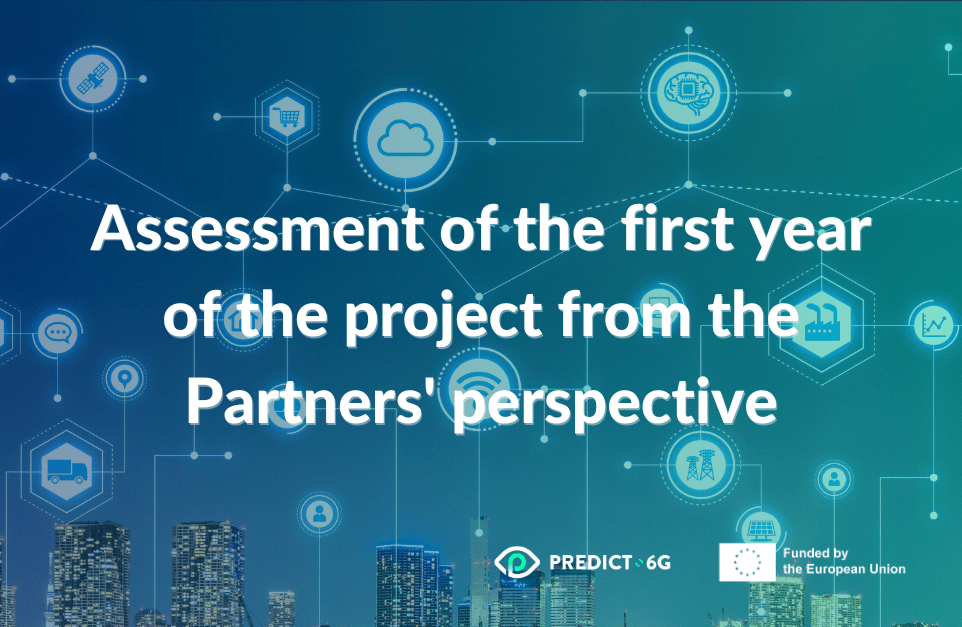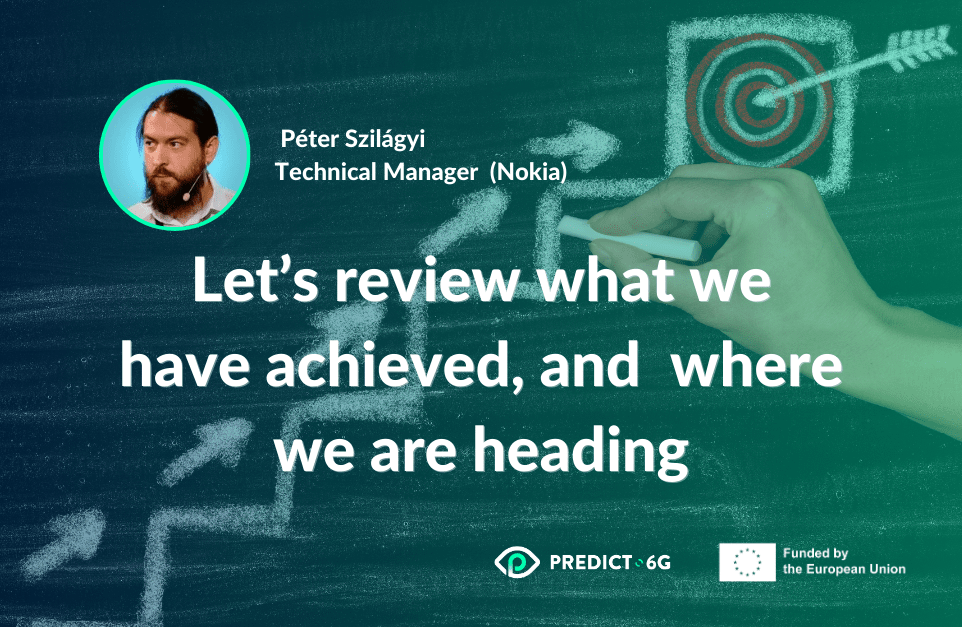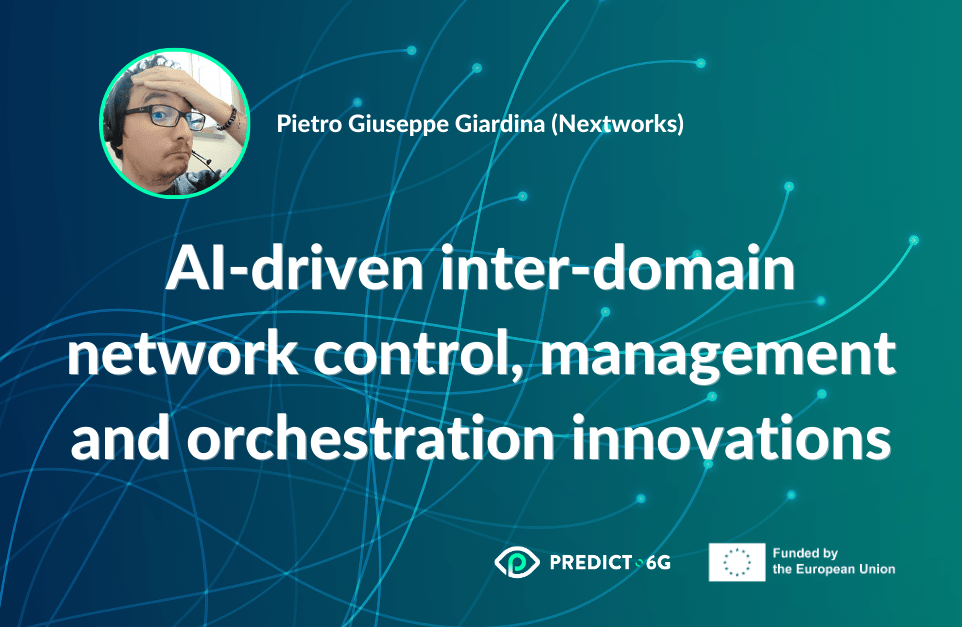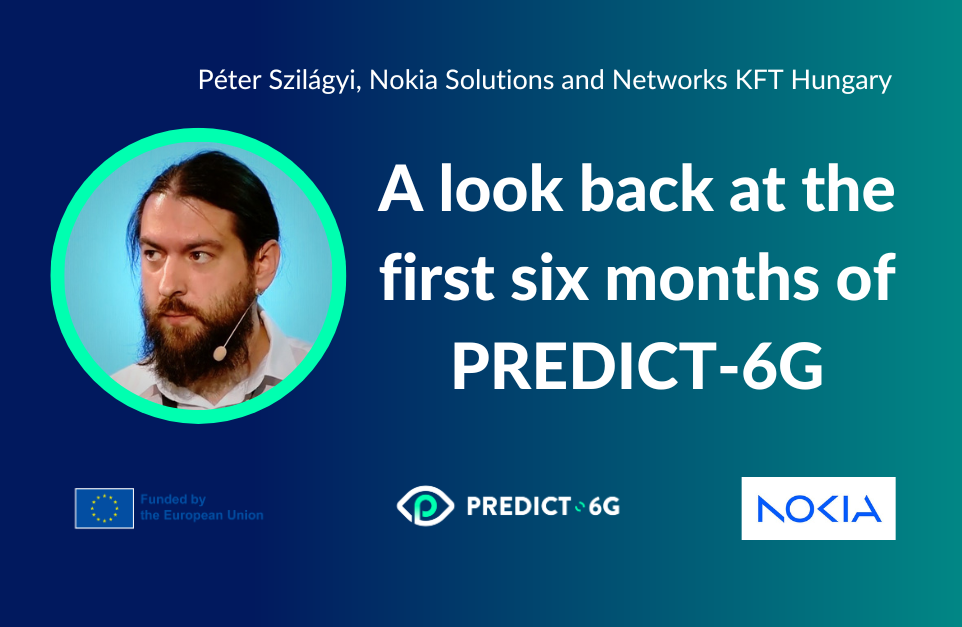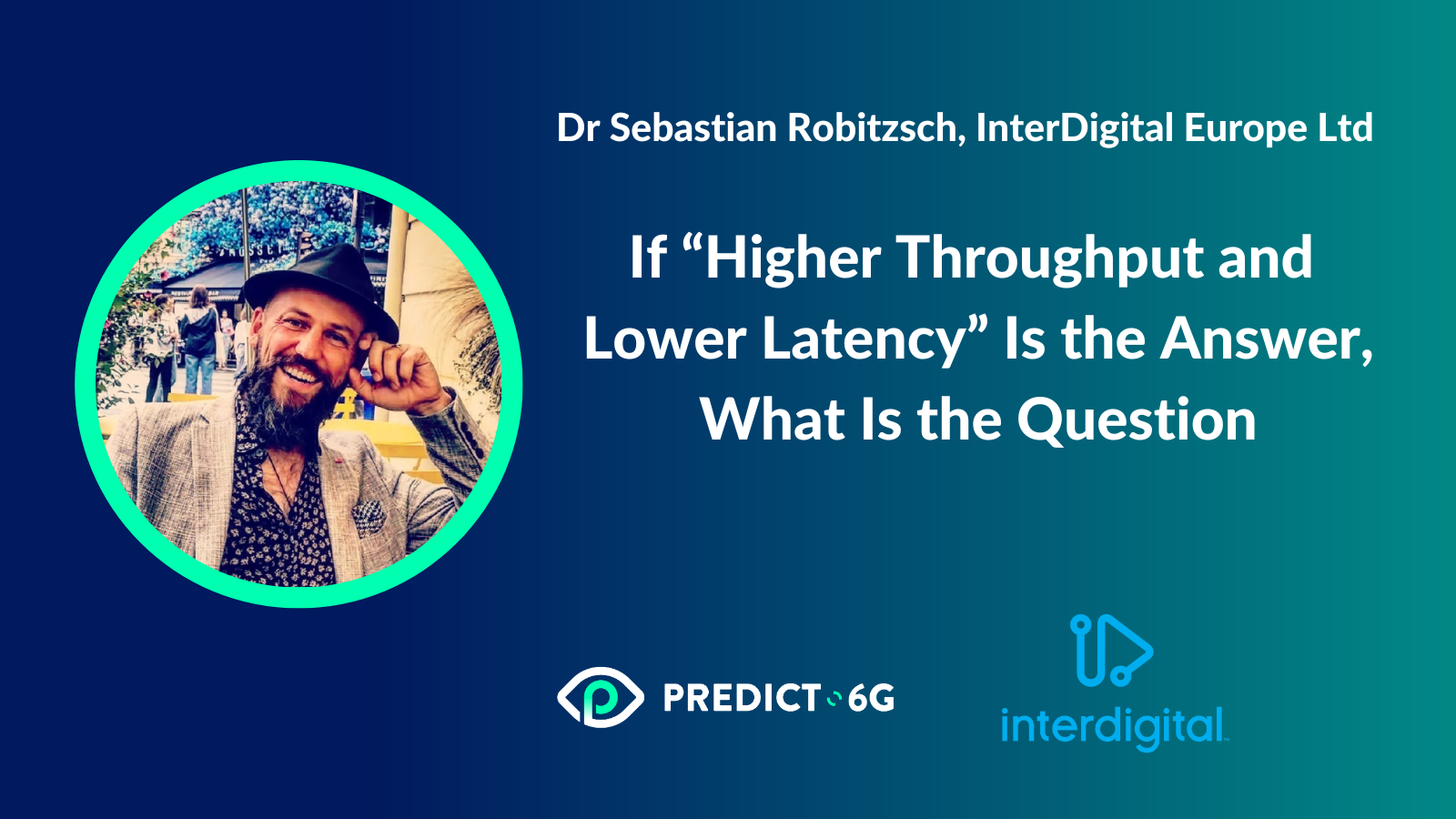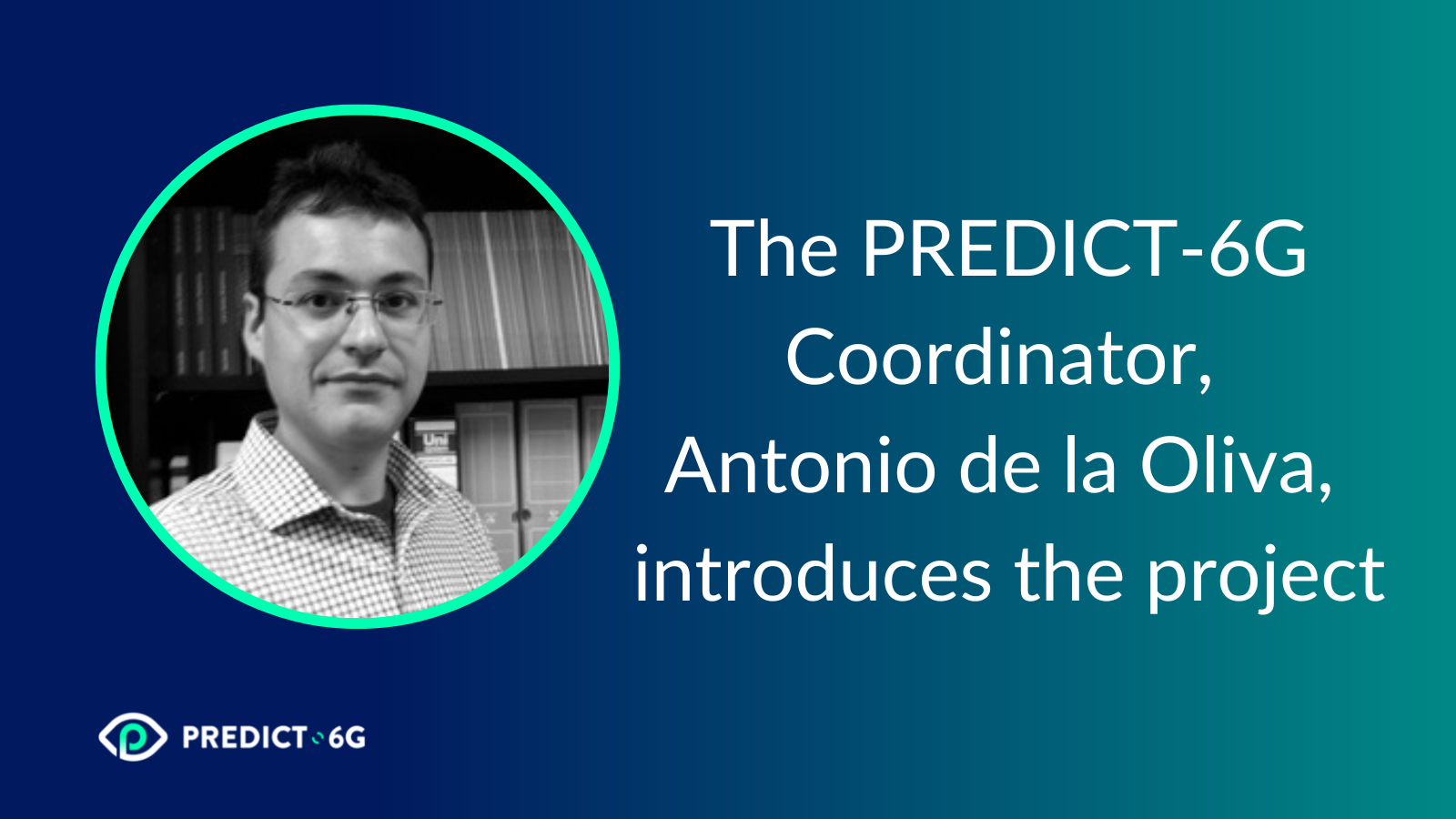One year of PREDICT-6G: 2023 review
By Antonio de la Oliva, Project Coordinator
The end of 2023 marks also the closing of the first year of the PREDICT-6G project. During this year, several key milestones have been achieved, setting the basis for the technical work of the second year. During the first months of 2023, PREDICT-6G focused on understanding the use cases which may benefit from deterministic networking innovations. The three use cases defined in the proposal - Smart manufacturing, Deterministic services for critical communications and multi-domain deterministic communications - have been extended to Localisation and Sensing, XR and IETF RAW and DetNet. With the inclusion of these new use cases, we believe the project sufficiently covers the requirements of current industries.
Based on the requirements and expected KPIs of the identified use cases, the main efforts of the year 2023 were dedicated to developing the system architecture and the principles of the Multi-Domain Dataplane (MDP) in WP2 and the AI-driven multi-stakeholder inter-domain Control Plane (AICP) in WP3. The work on the MDP and AICP design was synthetised into a full architecture specification, including E2E and domain level management service definition, E2E deterministic service architecture and lifecycle, MDP architecture and cross-domain U-plane integration enablers, system and service procedures, and Open APIs for technology integration with 3GPP and IETF DetNet domains.
Regarding the MDP, innovation areas were explored in the data-plane to enable cross-domain deterministic services, such as deterministic service continuity at domain borders, deterministic scheduler designs, cross-domain split of reliability and deterministic enablers, and time sync across multiple domains. Technologies consider 3GPP (with and without IETF DetNet integration support), IEEE TSC (with IETF DetNet), and novel Wi-Fi MAC capabilities. To support these technologies at the control level, the project follows an OpenAPI methodology defining the programmability layer on top of a network segment with the selected deterministic technologies, or even over network domains with no explicit support for determinism. The OpenAPIs are the interface between the PREDICT-6G MDP and AICP, enabling the technology-agnostic design for the AICP architecture. Current discussion within the project is the relation of the OpenAPIs with the DetNet component, and whether all different domains should be integrated below the DetNet control.
At its own pace, the AICP has also evolved significantly during 2023. The AICP follows a service-based architecture principle, where Management Services (MS) interact with each other via clearly defined APIs. MSs that share the same management scope are organised into Management Domains (MD). AICP defined a single MD for the E2E deterministic services, as well as separate MDs for each of the technology domains that are part of the initial release of PREDICT-6G’s MDP. This role split enables the AICP to govern any number of technological domains (i.e., 3GPP, IETF DetNet / IEEE TSN, Wi-Fi, and more) driven by the same end-to-end service focus. Individual Management Services implement capabilities such as service ingestion, service automation, path computation, digital twinning, AI-based predictions, measurement collection, and the exposure of topology, services, resources, and capabilities from domain level to end-to-end and from end-to-end to the consumer (e.g., user, operator) of PREDICT-6G.
At the end of 2023, the project also started the development and integration activities. Led by WP4, the first step was to define the methodology (sprint based agile development and integration cycles) and timeline for developing, integrating, and validating the PREDICT-6G system components. The design of Open Labs and the structure of the validation tests have also been central in this first year.
In conclusion, although the project is still in its infancy, we have a clear view on its merits and innovations, and the consortium is focused on achieving great impact in the industry, developing new technologies to create new deterministic networks.
Assessment of the first year of the project from the Partners' perspective
The PREDICT-6G consortium consists of 17 partners from seven countries working together to develop a multi-technology, multi-domain data plane that revises the reliability and time-sensitive design features existing in current wired and wireless standards.
While we all work towards a common goal, each partner has a specific role with concrete milestones. Thus, we have asked them about the highlights of PREDICT´s first year and what they expect to achieve in 2024.
UNIVERSIDAD CARLOS III DE MADRID
At UC3M, we have been mostly focused on developing several components of the MDP, specially on developing an open source XDP based bridge, which can be used to develop novel scheduling policies. We have also deployed multiple technologies to start building the MDP, including Wireless TSN, Ethernet-based TSN, Open Air interface 5G network, and programmable P4 switches.
During the second year of the project, through this infrastructure, we will focus on developing the WP3 components and prove the new approaches for the PREDICT-6G data plane.
In the first year of PREDICT-6G, ATOS+ATOSP’s main focus was the design of the AI-driven Inter-domain Control-Plane (AICP). In particular, ATOS+ATOSP led the efforts related to the architecture design of the inter-domain and network control mechanisms, assuming the responsibility of defining Service Automation Management Services. Additionally, the company was an active contributor to the composition of the AI/ML layout, taking the lead in the development of the AI/ML framework, which will be used by the project as the basis for building complex AI/ML algorithms.
Looking towards PREDICT-6G second year, ATOS+ATOSP will concentrate their efforts in the implementation of the Service Automation and the AI/ML framework modules, which are considered core services for showcasing the potential of the AICP in PREDICT-6G Proof-of-Concepts (PoCs).
This year was very important for partners to build a close relationship that would underpin all the project work, including the implementation of communication and dissemination strategy. Consolidating the PREDICT-6G branding, setting up the digital tools - website and social media - and overall, positioning the project in the SNS JU, were some of the main accomplishments in the last 12 months. Moreover, AUSTRALO established the first contacts with relevant stakeholders in the SNS community with very positive results.
In Year 2, AUSTRALO will continue to foster the PREDICT-6G community. In addition to the communication activities, the engagement with relevant stakeholders through targeted actions will accelerate to ensure the impact of the project. The dissemination of outcomes, as PREDICT-6G matures and the first results emerge, will be one of the priorities. We expect to support PREDICT-6G to become a reference in the SNS system architecture.
During the first year of PREDICT-6G, our main objective and area of work has been to identify security threats to predictive, multi-domain and technological 6G mobile networks, and corresponding challenges that need to be assessed through specific mechanisms and protocols. Following the completion of this work, next year we will focus on designing and developing mechanisms and protocols to provide the necessary security solutions.
CONSIGLIO NAZIONALE DELLE RICERCHE
In this first year, the CNR activities started with a comprehensive exploration of the State of the Art (SoA) in deterministic networks, with specific focus on Time-Sensitive Networking (TSN). The primary goal was to identify an effective methodology for assessing the performance of this emerging technology, particularly in terms of latency and jitter. Collaborative efforts were undertaken with all project partners to establish the architecture and define relevant case studies. In this sense, the definition of automation and robotics scenarios in line with the PREDICT-6G industrial case studies was done so as to allow gaining insight into the TSN application to information spreading and edge computing.
Subsequently, CNR people conceptualised a sophisticated software architecture designed to evaluate latencies in both individual devices and network infrastructures, incorporating scenarios with and without running synchronisation systems. At the same time, rigorous prototype implementation and test activities were conducted to assess TSN performance over WiFi. To this regard, some preliminary results of such activities have been presented in a paper published in the Proceedings of the IEEE ETFA 2023 International Conference.
In 2024, the CNR will investigate the framework described above to assess the performance of devices and analyse the results to create virtual counterparts for use in the Digital Twin. Installing a prototype hybrid wired/wireless/5G network to conduct test campaigns on the components of the PREDICT-6G architecture.
To perform realistic simulations of sensitive scenarios to study useful scaling laws and suggest control strategies to improve performance in deterministic communication and task completion.
In the first year of the project, the team dedicated their efforts to several key initiatives. A primary focus was the in-depth study and analysis of the Smart Factory use case. Internal workshops played a crucial role in establishing a first draft of the architecture framework needed for said use case. The project achieved a significant milestone with the delivery of D1.1, titled "Analysis of use case and system requirements." Additionally, the team delineated the requirements for both the Multi Data Plane (MDP) and the Control Plane.
As the project advances into its second year, the central emphasis shifts towards the design of the use case integration. This will be accompanied by the inaugural testing of the use case within the 5TONIC Open Lab. The outcomes of these tests will be documented to facilitate further experimentation and analysis in subsequent phases.
During the first year, the Consortium helped to define the architecture and interfaces between the AI-based control plane and the data plane innovations (e.g., exploitation of new Wi-Fi features for improved determinism). This outcome was a product of a dialog between experts in determinism in the different wired and wireless domains, addressing the challenges to integrate the available options in 3GPP, IEEE and IETF standards.
The implementation and integration of technologies in the testbed such as Wi-Fi based TSN, as well as E2E and domain-specific management services such as AI-based slicing will be central in 2024. The evaluation of the target KPIs defined in the project can then be assessed.
Working with so many talented individuals and impactful organisations towards the definition of deterministic communications in 6G has been the highlight of the first year.
In Year 2, InterDigital will prove the novel concept of Data Unit Groups,. This extension to IP headers will allow to treat a set of packets carrying a single Application Data Unit collectively, e.g. to map the information inside the IP header extensions to PDU Set Markers in 3GPP networks or to place them into specific TSN switch queues and/or to pre-empt them if deemed necessary to guarantee their QoS constraints. This innovation will be demonstrated an Integrated Sensing and Communication use case. 5TONIC serves as the TRL4 environment to validate the proof-of-concept.
The first year started in-depth analysis of the technical requirements imposed by the three use cases that will be demonstrated at the end of the project and the subsequent design of the system architecture. This was a huge work that was split in two parts: one focusing on the data-plane, and another on the control/management-plane. This design resulted in a PREDICT-6G architecture that is modular, with clear separation between technology domain management and end-to-end service management, which in turn enables extendibility to any new network technology without changing end-to-end principles.
The realisation of all PREDICT-6G components and their integration into a coherent system will be the priority in 2024. The implementation work has already started on a small scale, with a few code drops delivered at the end of 2023.
As far as POLITO activity was concerned, the first year of the project has been marked by acquiring competence in creating seamless deterministic services across network domains, employing a blend of telecommunications standards and innovative Wi-Fi technologies, all unified under a flexible OpenAPI-driven control architecture.
The main focus of the second year will be on providing deterministic guarantees in WiFi networks by exploring the potential of a comprehensive 802.11 scheduler that incorporates time, frequency, and space dimensions, with an emphasis on dynamic adaptation to variable traffic and radio channels. The objective will be to efficiently allocate deterministic traffic while maximising throughput for other traffic, incorporating frequent scheduling updates and considering the integration of preamble puncturing for future-proofing against emerging WiFi standards.
UNIVERSITAT POLITÈCNICA DE CATALUNYA
In its inaugural year, the UPC group achieved significant milestones in different key areas: dynamic scheduling for radio resource management in mixed traffic types for private 5G networks, and AICP Management Services (MSs) to support E2E services provisioning and maintenance.
Dynamic Scheduling for Radio Resource Management in Mixed Traffic Types for Private 5G Networks involved substantial progress in the domain of dynamic scheduling and OFDMA radio resource management in the context of mixed traffic types (Isochronous TSN, Asynchronous TSN and Best Effort (BE)) within private 5G networks deployed in industrial settings. This entails the effective allocation of resources and admission control in response to the varying communication demands of diverse traffic types. The outcomes of this effort include improved spectral efficiency, reduced latency/jitter and enhanced reliability, all crucial factors for the successful integration of 5G technologies in private networks and the support of a range of applications in the industrial domain.
On the other hand, UPC actively contributed to the design and preliminary implementation of AICP MSs, such as Digital Twin for KPI evaluation and Path Computation, both at technology domain level and at the E2E level. Both MSs are essential for the deterministic services provisioning assuring their requirements and represent significant components of the PREDICT-6G AICP.
In conclusion, the first year has been marked by commendable progress. These achievements reflect the initiative's commitment to advancing research in the field of deterministic services, laying a solid foundation for continued exploration and innovation in the months to come.
Building on the achievements of the first year, the second year of PREDICT-6G considers the following focused areas to further advance the research and development:
- Advanced Dynamic Scheduling and Resource Management in Mobility Scenarios: This involves refining and enhancing dynamic scheduling algorithms for radio resource management, placing a particular emphasis on the allocation of resources in mobility scenarios where handovers should not affect the continuity of the service. To that end, we will consider the resource allocation for the Dual Active Stack Protocol handover. We will incorporate machine learning techniques to enable the network to adapt to UL/DL traffic variability and learn from dynamic industrial environments, ensuring improved performance.
- Development and integration of a Digital Twin module for KPI evaluation as part of the AICP.
- Development and integration of a Path Computation modules as part of the AICP.
- Integration on the Advanced Dynamic Scheduling and Resource Management in the Digital Twin: Explore the integration of the studied technologies to augment the capabilities through the integration of the schedulers in the E2E digital twin tool. Investigate how these technologies can synergize with dynamic scheduling approaches to enhance reliability, latency and real-time decision-making about the admission and rejection of traffic flows.
- Standardisation and Industry Adoption: Engage with pre-standardization bodies and industry stakeholders to contribute insights and findings to the development of 6G standards.
If you want to stay updated about PREDICT-6Gt, subscribe to our newsletter and follow us on Twitter and LinkedIn!
Let’s review what we have achieved, and where we are heading
By Péter Szilágyi, Technical Manager
Time flies so quickly when you are on a great team and working on an inspiring project! It feels like we have just started, yet it has been one whole year since PREDICT-6G kicked off. It has been a busy time, with lots of studies, planning, design, discussions, and deliverables. But the hard work has paid off: at the end of the year, we have created what we can claim to be a solid foundation of the project, both conceptually and practically. Let’s review what we have achieved, and what we are heading for, in more detail.
2023 summary
Looking back on the first year, it has been an intense study phase for the PREDICT-6G project. At the beginning, there were lots of questions around how to create multi-domain deterministic networks: what technologies to use, how to enable inter-working between different technological and administrative domains, and, above all, how to automate the service management in end-to-end so that it remains scalable to onboarding additional network technologies yet remains independent (as much as possible) from each technology’s specificities and limitations. We started the exploration by considering the technical requirements imposed by the three use cases that will be demonstrated at the end of the project. With this outcome-oriented methodology, we ensure that the PREDICT-6G system will be capable of delivering the needs of real-world scenarios. Based on the requirements, we designed the architecture of the system. This was a huge work that was split in two parts: one focusing on the data-plane, and another on the control/management-plane. These parts were investigated in parallel, but not at all in isolation: the idea was that data-plane technology enablers will be up-streamed and consolidated towards the control/management plane so that it can work on convenient abstractions instead of the raw controller layer of the L2/L3 technologies. This design resulted in a PREDICT-6G architecture that is modular, with clear separation between technology domain management and end-to-end service management, which in turn enables extendibility to any new network technology without changing end-to-end principles. The evolution of this work can be found in D1.1, D2.1 and D3.1, with D1.2 providing a standalone reference merging all PREDICT-6G architecture matters into a single document. Additionally, D2.2 and D3.2 provide reports on early implementation efforts, showing that PREDICT-6G no longer exists solely on paper but already now there is some code to be executed. Also, D4.1 reports on the integration plan that will bridge us over to the next year and set the next big piece of work in motion: the implementation of the PREDICT-6G system.
2024 outlook
A year’s start is just as good as the previous year’s end. That said, looking at the end of 2023 we have high hopes for 2024. Clearly, the biggest effort in 2024 will be the realisation of all PREDICT-6G components and their integration into a coherent system. The implementation work has already started on a small scale, with a few code drops delivered at the end of 2023, but the bulk of the work remains to be completed next year. Although we have a firm design and do not expect major changes to the architecture, experience shows that implementing a system for the first time never leaves the plans untouched, however carefully they were designed in the first place. Therefore, implementation is not going to be a one-way exercise, but it will evolve the thinking, understanding and design of the system as well. At the end, all will be for the benefit of the technical content that the project will deliver, so we are very much looking forward to changes rather than trying to avoid them.
All in all, PREDICT-6G is progressing according to the project plan – it has finished all work scheduled for the first year, and has a solid foundation to become a reality in 2024. This year was rich in deliverables, having released a total of 12, exactly one per month on average. 2024 will be quieter in terms of deliverables, with only two of them scheduled; yet under this seemingly calm surface things will get rather busy in the Open Labs of Madrid and Budapest. Have a fantastic year end and stay tuned for more PREDICT-6G in 2024!
AI-driven inter-domain network control, management, and orchestration innovations
By Pietro Giuseppe Giardina, Nextworks
Network technologies are in continuous evolution. The technological advancements led to more powerful networks characterised by high transport capabilities (large throughputs, reduced latency, etc.). Furthermore, the progressive softwarisation of the network, thanks to new paradigms such as Software Defined Networking (SDN) and Network Software Virtualisation (NFV) opened the door to a completely new set of network stakeholders beyond the role of the classical Telco Operator: vertical industries but also specialised software houses, resource providers (e.g., storage, transport, spectrum) service providers, etc.
All those stakeholders want to exploit the resources and the capabilities of the new networks, driven by different interests. A telco operator may be interested in integrating new technologies to increment the capabilities of its own network while reducing the integration cost and the network devices’ configuration overhead. On the contrary, a vertical service provider may be more interested in consuming network capabilities to deploy vertical services, without dealing with the complexity of the network itself.
With the advent of 5G, telco operators started studying the adoption of specific technologies i.e., Network Service Orchestrators and SDN Controllers, capable to abstract the network complexity and offer simple and effective interfaces for service orchestration and network management and control, allowing verticals to create their own services across a well-defined dedicated set network resources (e.g., network slices). Nevertheless, with the growing of the network capabilities, the services are becoming more complex accordingly and more demanding in terms of network resources, reliability, and pervasiveness. AR/XR, high-quality video stream services, autonomous driving, etc. are examples of services designed for the last generation of networks.
However, to be truly pervasive, such services cannot be limited to a single network domain (e.g., one Telco Operator), but require to be deployed across multiple network domains, potentially belonging to different network operators, and characterised by different network technologies.
The lifecycle management and control of services across multiple networks in a transparent manner for the requestor is a challenge for the management plane. The provisioning of a similar service requires a management plane platform capable of coordinating with the different network domains, creating local subservices and stitching them all together for building a unique E2E service. Its architecture should be modular, flexible, and easily extendable to new network domains and technology, while preserving the right level of abstraction.
Research projects and SDOs have widely investigated the problem. In particular, ETSI ZSM ISG (Zero-touch network and Service Management Industrial Specification Group) released a set of standards (GS, Group Specification) which widely discussed the problem of multiple domain networks and service management [1].
The preservation of the requested quality of service (QoS) at runtime is a challenge for the control plane. Again, Research and SDOs have given their contribution over the years, developing the concept of network and service automation (zero-touch) based on control loops (CL). Network and service automation is where AI can play a crucial role. One of the main objectives of the 6G is indeed the integration of AI technologies in network control and management systems by design, for a number of tasks so far accomplished mostly by human operators. The objective is to guarantee a timely reaction to the changes that characterise the network dynamicity and reduce the errors (and the human intervention in general) at the same time. ETSI ENI and ETSI ZSM [2] [3] propose solutions for network and service automations supporting AI. Hexa-x and Hexa-x-II are the most recent examples of EU-funded research projects incorporating AI-based CLs in 6G architecture.
Similarly, Digital Twinning technologies allow to emulate/simulate the behaviour of the target network (or specific segments) in order to predict its future states when applying a given configuration. ETSI is producing a report in this regard, ZSM-015 [4].
PREDICT-6G tackles the multi-domain service orchestration and automated network and service control in the challenging domain of time-critical services.
When the focus moves towards the orchestration of time-critical services, e.g., the remote control of industrial processes, the challenge for management and control become even more complex. Time-sensitive services require reliable network infrastructure capable of delivering information in a deterministic manner (delivery within a specific timeframe, fixed order of arrival of the messages, etc.). Several deterministic network technologies are nowadays available (IEEE TSN, IETF DetNet, IETF RAW), with different levels of maturity and very limited interoperability.
To deal with this heterogeneity, PREDICT-6G applies both SBA (Service-Based Architecture) and ZSM architectural concepts for the orchestration of E2E deterministic services, across multiple technologies whose level of support to the determinism may significantly vary and could be even zero.
AI/ML and Digital twinning technologies are employed at both Management and Control level for optimal deterministic path computation and resource allocation, KPI prediction and QoS preserving at runtime. Both of them are supported by a pervasive monitoring facility providing the data in near real-time.
References:
[1] ETSI GS ZSM 002 V1.1.1 (2019-08). Zero-touch network and Service Management (ZSM); Reference Architecture
[2] ETSI GS ENI 005 V2.1.1 (2021-12). Experiential Networked Intelligence (ENI); System Architecture
[3] ETSI GS ZSM 009-1 V1.1.1 (2021-06). Zero-touch network and Service Management (ZSM); Closed-Loop Automation; Part 1: Enablers
[4] ETSI GR ZSM 015 Zero-touch network and Service Management (ZSM); Network Digital Twin Stable draft available here: https://portal.etsi.org/webapp/workProgram/Report_Schedule.asp?WKI_ID=64372
How will PREDICT-6G contribute to the European Digital Decade?
“Europe aims to empower businesses and people in a human-centred, sustainable and more prosperous digital future.”
“A Europe fit for the digital age” is one of the six European Commission priorities for 2019-2024. It addresses the need to prepare European citizens and businesses for the digitisation of the society and economy, while contributing to a climate-neutral Europe.
The 2030 Digital Compass reflects this common vision for the EU, highlighting the importance of securing Europe's digital sovereignty and resilience. The Digital Decade Policy Programme 2030 sets a governance framework for a structured multi-country cooperation that guides Europe´s digital transformation, while the European Declaration on Digital Rights and Principles, in alignment with the EU core values and fundamental rights, outlines the human-centred approach and the focus on sustainability of the digital transformation.
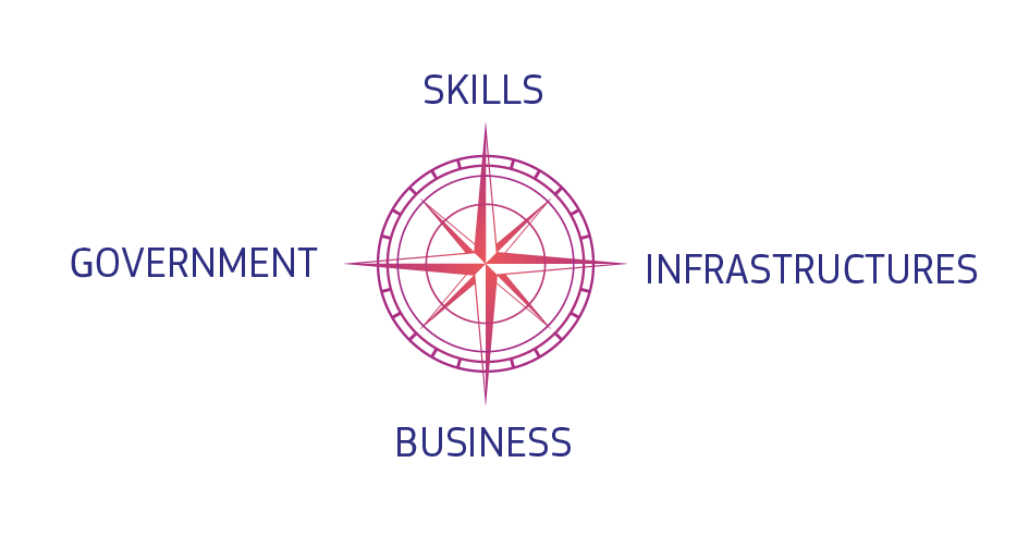
Empowering people, businesses and public services with a new generation of technologies that expand their capabilities is crucial to seize the potential of digital transformation. Underpinned by science, research and innovation, and focusing on data, technology, and connectivity, Europe should set the path of the global digital revolution.
PREDICT-6G spearheads the creation of a secure, modular, interoperable, and extensible deterministic network and management framework that automates the definition, provisioning, monitoring, fulfillment, and life-cycle management of end-to-end (E2E) deterministic services spanning through multiple network domains.
This new architecture will allow large E2E deterministic paths across domains and technologies, through networks transporting a mix of deterministic and non-deterministic traffic. It will be managed by a novel AI-based multi-stakeholder interdomain control-plane framework. The network will be reliable, time sensitive and will behave in a predictable way, anticipating possible congestion issues, so the application and network control mechanisms are never compromised.
The design of new deterministic approaches is addressed by all major Standards Developing Organisations (SDOs). However, while there are ongoing efforts to create data-plane enablers for deterministic networking in specific technology domains, there is no holistic E2E programmable service architecture that can deliver deterministic services over multiple technologies and traversing multiple domains. PREDICT-6G will contribute to bridge that gap.
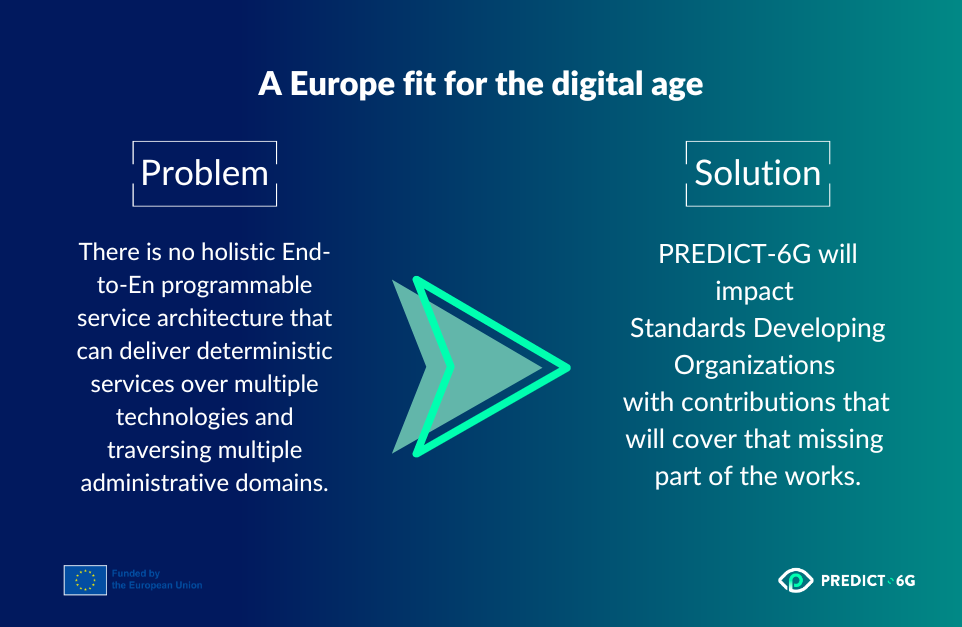
The solution will be tested in use cases focused on smart manufacturing and critical communications, but it is foreseen that audio and video streaming, industrial automation, cloud robotics, Internet of Things (IoT), Digital Twins (DT), and connected vehicles, among others, will benefit from these networking capabilities. A deterministic 6G will change the networking paradigm, fostering new business cases and applications that will help to accelerate the digitisation of the industry.
PREDICT-6G aim to create a tangible impact in the standardisation community and overall, supporting Europe's role in global standards, is reflected in the project´ standardisation roadmap and the establishment of a Standardisation Advisory Committee (SAC), responsible for overseeing the implementation of the roadmap and monitoring the work being developed at different SDOs and Working Groups. International cooperation on standards is one of the priorities of the EU.
Beyond its potential impact in the industry and the general digital capabilities of the networks and, as an innovation and research project, PREDICT-6G is committed to open science practices. The dissemination and communication of the knowledge created within PREDICT-6G is helping the project to reach a broad audience and engage relevant stakeholders. Likewise, the active involvement of PhD and PostDoc students in the project work is directly contributing to training highly skilled digital professionals that will reinforce the European workforce.
If you want to always stay updated about our project, subscribe to our newsletter and follow us on Twitter and LinkedIn!
A look back at the first six months of PREDICT-6G
By Péter Szilágyi, PREDICT-6G Technical Manager
It’s been six months since PREDICT-6G kicked off, and the wheels – prepared carefully during the planning – were set in motion. Within that time, we have built a well functioning team, gained remarkable momentum, and started to fill our pipeline of technology and innovation. This article reflects on the key achievements so far, the status of the project, and the next steps – from a technical perspective.
What we have achieved
The first period of the project focused on setting the landscape, collecting and structuring ideas, discussing and documenting our approach to multi-domain deterministic networks and services, and roadmapping the underlying technical work. We have established solid understanding of the use cases (such as smart manufacturing and industrial critical communication) requiring deterministic services across multiple domains. For each use case, we studied the end-to-end communication requirements, the capabilities of the devices, the types and roles of the actors and their anticipated demand and traffic mix. The findings were consolidated and generalized to produce system level and service level KPIs and requirements, serving as design principles and capabilities towards the PREDICT-6G system. Based on the requirements, we have already created the first architecture blueprint of the project, including both the multi-technology multi-domain data plane and the AI-driven inter-domain control plane, as well as the means of their interworking. On the groundwork side, we have established a roadmap for the two Open Labs where the PREDICT-6G technology and innovations will be implemented and demonstrated through the selected use cases. Finally, we have created two important pieces of deliverables: our Data Management Plan (DMP), which defines the standards for preparing, publishing and maintaining open access to all types of data, including documentation, measurements and source code to be produced by PREDICT-6G; and our first version of the communication, dissemination, standardization and exploitation strategy plan.
Where we are now
We are in a busy schedule paved with deliverables on all of our research directions. We are just releasing D1.1, our first technical report summarizing the use cases, requirements and initial architecture of the PREDICT-6G. I recommend reading this document for those who would like to get familiar with the project’s technical line of thought and innovation areas, as these aspects already started to manifest in this work. In parallel to finishing D1.1 under WP1, we are cooperating very closely between two of our other technical work packages: WP2, which is defining the deterministic technologies for data planes and cross-domain data plane integration; and WP3, which is defining the automation framework on the control and management plane to self-orchestrate and autonomously assure end-to-end deterministic services. These two WPs are expected to be the busiest ones in the next four months, as they work together to co-create two sets of dependent technologies. On the one hand, in WP2, to expose programmable data plane capabilities from within specific network technologies such as 3GPP, IETF DetNet/RAW, and Wi-Fi; and on the other hand, in WP3, to utilize those exposed capabilities to autonomously fulfil and assure the end-to-end services. Additionally, WP4 takes off in July, to start working on system integration aspects that would bring all PREDICT-6G technical components into the same autonomous framework.
Looking ahead
Summer will be hot for PREDICT-6G, and not only for the season. We will produce our next two deliverables, which are going to consolidate part of the effort we are currently putting into the cross-WP2-WP3 work. To be released at the end of August, D2.1 will descend deeper into the data plane technologies, whereas one month later, D3.1 will report the first results on the control and management plane technologies, already leveraging the capabilities of our data plane. These deliverables will maintain close coherence and context with each other and with D1.1, so that interested readers can easily navigate the breadths and depths of the PREDICT-6G technology. These two upcoming deliverables will also set up the forward path to their second versions, which are both due near the end of this year, going even deeper into their subjects. By that time, PREDICT-6G will have created and released substantial technical capital that will be a foundation for starting lab work in 2024.
Summary
Nowadays are intense yet interesting times in PREDICT-6G. Our momentum accelerates, the frontier of the research broadens, and the number of ongoing activities increase. While this means that work is split up and task forces are focusing on specific areas of PREDICT-6G to maintain efficiency and productivity, we take special care to leverage cross-WP and cross-partner expertise as we drive along our micro-objectives. All in all, we have an excellent team working together on a research project with a great aim – and that is all that’s needed.
If you want to always stay updated about our project, subscribe to our newsletter and follow us on Twitter and LinkedIn!
How Networks Can Help Machine Learning to Becoming (Truly) Pervasive
By Prof. Carla Fabiana Chiasserini, Politecnico di Torino, Italy
Prof. Carla Fabiana Chiasserini, member of the PREDICT-6G Consortium on behalf of Politecnico di Torino, Italy, highlights the challenges that the ubiquitous use of machine learning is posing and how the PREDICT-6G project is developing solutions to make it sustainable.
Machine Learning (ML) is all around: it is becoming an essential component of many user applications and network services. However, we all know that training and executing a ML model may exact a significant toll from the computational and network infrastructure due to its high resource demand. Consequently, current implementations of ML operations are heavy energy consumers, which makes the pervasiveness of ML we are witnessing not sustainable.
PREDICT-6G is committed to find breakthrough approaches to take and solve the challenge. Specifically, it has tackled the use of services for the optimal configuration of virtualized radio interfaces and of user applications at the network edge, for which ML can be the problem and the solution at the same time.
Network Function Virtualization (NFV) and edge computing are indeed disrupting the way mobile services can be offered through mobile network infrastructure. Third parties such as vertical industries and over-the-top players can now partner up with mobile operators to reach directly their customers and deliver a plethora of services with substantially reduced latency and bandwidth consumption. Video streaming, gaming, virtual reality, safety services for connected vehicles, and IoT are all services that can benefit from the combination of NFV and edge computing: when implemented through virtual machines or containers in servers co-located with base stations (or nearby), they can enjoy low latency and jitter, while storing and processing data locally.
The combination of NFV, edge computing, and an efficient radio interface, e.g., O-RAN, is therefore a powerful means to offer mobile services with high quality of experience (QoE). However, user applications are not the only ones that can be virtualized: network services such as data radio transmission and reception are nowa- days virtualized and implemented through Virtual Network Functions (VNFs) as well; and both types of virtual services, user’s and network’s, may be highly computationally intensive. On the other hand, it is a fact that computational availability at the network edge is limited. It follows that in the edge ecosystem, user applications and network services compete for resources, hence designing automated and efficient resource orchestration mechanisms in the case of resource scarcity is critical.
Further, looking more closely at the computational demand of virtualized user applications and at that of network service VNFs, one can notice that they certainly depend on the amount of data each service has to process, but they are also entangled. As an example, consider a user application at the edge and (de-)modulation and (de-)coding functions in a virtualized radio access network (vRAN). For downlink traffic, the application bitrate determines the amount of data to be processed by the vRAN; on the contrary, for uplink traffic, the data processed by the vRAN is the input to the application service. A negative correlation, however, may also exist: the more data compression is performed by a user application, the higher its computational demand, but the smaller the amount of data to be transmitted and the less the computing resources required by the vRAN. In a nutshell, a correlation exists between the amount of data processed/generated by virtual applications at the edge and network services VNFs, and such correlation can be positive or negative depending on the type of involved VNFs. Experimental tests performed within PREDICT-6G clearly show such correlation.
Then, owing to the complex involved dynamics, PREDICT-6G has developped a scalable reinforcement learning-based framework for resource orchestration at the edge, which leverages a Pareto analysis for provable fair and efficient decisions. The developed framework, named VERA [1], meets the target values of latency and throughput for over 96% of the observation period and its scaling cost is 54% lower than a traditional, centralized framework based on deep-Q networks.
[1] S. Tripathi, C. Puligheddu, S. Pramanik, A. Garcia-Saavedra and C. F. Chiasserini, "Fair and Scalable Orchestration of Network and Compute Resources for Virtual Edge Services," in IEEE Transactions on Mobile Computing, doi: 10.1109/TMC.2023.3254999.
If you want to always stay updated about our project, subscribe to our newsletter and follow us on Twitter and LinkedIn!
If “Higher Throughput and Lower Latency” Is the Answer, What Is the Question
By Dr Sebastian Robitzsch, InterDigital Europe Ltd
It is anticipated that 6G standardisation will start in 2025 and the industry is already sharpening their tools, noticeable in the various 6G-related themes at exhibitions, panels and conferences to kickstart the conversation what 6G is all about. In particular, the pre-standardisation work is already running at full steam in bodies such as ETSI and NGMN, focusing on technologies and requirements. With the first phase of 6GIA’s SNS projects kicked off earlier this year, such as PREDICT-6G, the European community is contributing to the global 6G technology and standardisation process.
Any conversation around the “next G” is rooted in its requirements and use cases, followed by Key Performance Indicators (KPIs) to quantify any “next G” technology against the promises made. 6G is no different in that approach and 3GPP has already seen numerous technical reports which study services that can be categorised as 6G, when looking at the 2025 timeframe.
One of the dominant use cases in that regard is one or a mix of augmented, virtual, extended reality (AR/VR/XR) services, which demand the typical KPIs around throughput, latency, jitter, reliability, etc. to be further pushed to new limits. 3GPP is working on a feasibility study for these services [1] and Table 1 provides a summary assessment for KPIs. In addition to the work in 3GPP, the IETF MOPS WG [2] also provides additional values which have been folded into the KPIs in Table 1. As can be seen, three service types have been identified, i.e. video, audio and haptic, and a set of KPIs with detailed upper bound numbers for each of them.
Table 1: Key Performance Indicators for Remote Collaboration [1,2].
| KPI | Video | Audio | Haptics |
| Throughput [kbit/s] | 2500 – 200000 | 64 – 512 | 512 – 1024 |
| Jitter [ms] | ≤ 30 | ≤ 30 | ≤ 2 |
| Latency [ms] | ≤ 100 (lip sync limit)
≤ 150 (preferred) ≤ 400 (limit) |
≤ 150 | ≤ 50 |
| Packet Loss [%] | ≤ 1 | ≤ 1 | ≤ 10 |
| Update Rate [Hz] | ≥ 30 | ≥ 50 | ≥ 1000 |
| Packet Size [bytes] | ≤ MTU | 160 – 320 | 64 – 128 |
| Reliability [%] | 99.9 | 99.99999 | 99.999999 |
However, one can certainly argue that 5G is capable to deliver on these KPIs from a technology perspective, considering the option of private network deployments (aka Non-Public Networks), which enable fine-tuned network deployments towards service-specific packet deliveries [3]. That is why the added KPIs in [1], around inter-service-type delay numbers defining upper bound numbers of how much later a service type can arrive after another one, can be considered as impossible to request and deliver in 5G systems. Additionally, pre-standardisation bodies such as NGMN and 5G-PPP share a common understanding beyond a purely KPI-driven conversation on 6G requirements via added Key Value Indicators (KVIs)[4,5]. The rational here is to allow a value-driven conversation around innovations in 6G instead of a KPI one. And PREDICT-6G is not different in that regard by focusing on the three pillars of deterministic communications, i.e. predictability, reliability and time sensitivity; these three pillars are considered in a multi-domain scenario and in an end-to-end fashion.
When considering the KPIs provided in Table 1 and adding the ability to deterministically control the communication on the User Plane, the KVI conversation around the “added value” to 6G becomes the centre argument and a key differentiator to 5G. Thus, AR/VR/XR use cases provide an ideal narrative for the importance of deterministic communications in PREDICT-6G and the wider pre-standardisation community.
| [1] | 3GPP, “Technical Report 23.856: Feasibility Study on Localized Mobile Metaverse Services (Release 19)”, Nov 2022. |
| [2] | R. Krishna and A. Rahman, “Media Operations Use Case for an Extended Reality Application on Edge Computing Infrastructure”, Online: https://datatracker.ietf.org/doc/draft-ietf-mops-ar-use-case/ |
| [3] | 5G-PPP Technology Board, “Non-Public-Networks – State of the art and way forward”, Nov 2022. Online: https://5g-ppp.eu/wp-content/uploads/2022/11/WhitePaperNPN_MasterCopy_V1.pdf |
| [4] | NGMN, “6G Requirements and Design Considerations”, Feb 2023. Online: https://www.ngmn.org/wp-content/uploads/NGMN_6G_Requirements_and_Design_Considerations.pdf |
| [5] | 5G-PPP, “Beyond 5G/6G KPIs and Target Values”, Jun 2022. Online: https://5g-ppp.eu/wp-content/uploads/2022/06/white_paper_b5g-6g-kpis-camera-ready.pdf |
If you want to stay updated about PREDICT-6Gt, subscribe to our newsletter and follow us on Twitter and LinkedIn!
The PREDICT-6G Coordinator, Antonio de la Oliva, welcomes you on board
By Antonio de la Oliva
Welcome to PREDICT-6G! Today, we will be discussing the PREDICT-6G project, which aims to create a secure, modular, interoperable, and extensible deterministic network and management framework that automates the definition, provisioning, monitoring, fulfillment, and life-cycle management of end-to-end (E2E) deterministic services over multiple network domains.
The PREDICT-6G project is part of the Smart Networks and Services Joint Undertaking (SNS JU), which is a public-private partnership between the European Commission and the European ICT industry. The SNS JU selected 35 research, innovation, and trial projects to enable the evolution of 5G ecosystems and promote 6G research in Europe.
The PREDICT-6G project aims to create a deterministic network. PREDICT-6G defines deterministic as predictable, reliable and time sensitive. Network predictability refers to the ability of a network to provide consistent and dependable service with a known level of performance. Network reliability refers to the ability of a network to transfer data without losses in a consistent way. In the context of deterministic networking, predictability and reliability are achieved through clock synchronization, service protection, redundancy, and other mechanisms that ensure guaranteed bandwidth, bounded latency, and other properties germane to the transport of data. Time sensitiveness provides guaranteed bandwidth, bounded latency, and other properties that are important for the transport of time-sensitive data. PREDICT-6G will extend current mechanisms defined in IEEE 802.1 and IETF DetNet/RAW SDOs to provide determinism to the general multi-domain, multi-technology upcoming 6G network.
Currently, the project is focused on determining the key use cases and deriving the KPIs/KVIs to be met by the solutions designed within the project. Use cases for deterministic networking include closed-cycle control loops, automotive and other transportation systems, industrial automation, audio and video streaming, and more. Deterministic networking can support a wide range of applications, each with different Quality of Service (QoS) requirements, and can operate in vastly different environments with different scaling. That is reliable, secure, and scalable. The use cases currently identified in the project focus on industrial environments, meta-verse and XR/VR applications.
In summary, the project will develop new technologies and protocols to enable end-to-end deterministic services over multiple network domains. The project will also develop a management framework that automates the provisioning, monitoring, and life-cycle management of these services. The PREDICT-6G project is an important step towards the development of 6G networks, which are expected to emerge in 2030.
If you want to stay updated about PREDICT-6Gt, subscribe to our newsletter and follow us on Twitter and LinkedIn!


